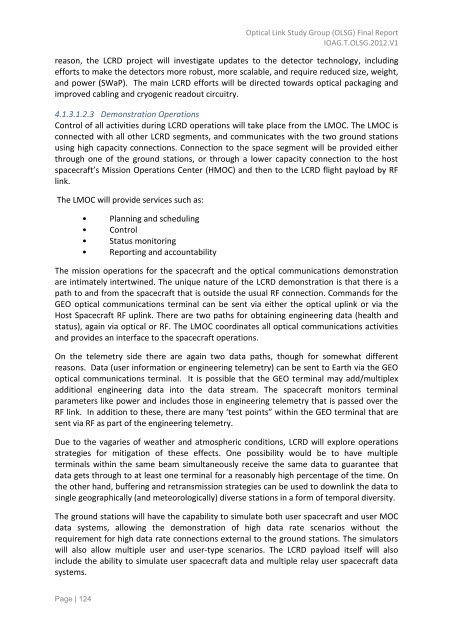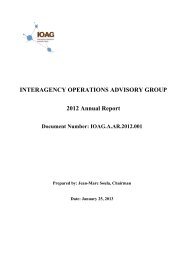OLSG Report_Final_06_05_12 - Interagency Operations Advisory ...
OLSG Report_Final_06_05_12 - Interagency Operations Advisory ...
OLSG Report_Final_06_05_12 - Interagency Operations Advisory ...
You also want an ePaper? Increase the reach of your titles
YUMPU automatically turns print PDFs into web optimized ePapers that Google loves.
Optical Link Study Group (<strong>OLSG</strong>) <strong>Final</strong> <strong>Report</strong><br />
IOAG.T.<strong>OLSG</strong>.20<strong>12</strong>.V1<br />
reason, the LCRD project will investigate updates to the detector technology, including<br />
efforts to make the detectors more robust, more scalable, and require reduced size, weight,<br />
and power (SWaP). The main LCRD efforts will be directed towards optical packaging and<br />
improved cabling and cryogenic readout circuitry.<br />
4.1.3.1.2.3 Demonstration <strong>Operations</strong><br />
Control of all activities during LCRD operations will take place from the LMOC. The LMOC is<br />
connected with all other LCRD segments, and communicates with the two ground stations<br />
using high capacity connections. Connection to the space segment will be provided either<br />
through one of the ground stations, or through a lower capacity connection to the host<br />
spacecraft’s Mission <strong>Operations</strong> Center (HMOC) and then to the LCRD flight payload by RF<br />
link.<br />
The LMOC will provide services such as:<br />
• Planning and scheduling<br />
• Control<br />
• Status monitoring<br />
• <strong>Report</strong>ing and accountability<br />
The mission operations for the spacecraft and the optical communications demonstration<br />
are intimately intertwined. The unique nature of the LCRD demonstration is that there is a<br />
path to and from the spacecraft that is outside the usual RF connection. Commands for the<br />
GEO optical communications terminal can be sent via either the optical uplink or via the<br />
Host Spacecraft RF uplink. There are two paths for obtaining engineering data (health and<br />
status), again via optical or RF. The LMOC coordinates all optical communications activities<br />
and provides an interface to the spacecraft operations.<br />
On the telemetry side there are again two data paths, though for somewhat different<br />
reasons. Data (user information or engineering telemetry) can be sent to Earth via the GEO<br />
optical communications terminal. It is possible that the GEO terminal may add/multiplex<br />
additional engineering data into the data stream. The spacecraft monitors terminal<br />
parameters like power and includes those in engineering telemetry that is passed over the<br />
RF link. In addition to these, there are many ‘test points” within the GEO terminal that are<br />
sent via RF as part of the engineering telemetry.<br />
Due to the vagaries of weather and atmospheric conditions, LCRD will explore operations<br />
strategies for mitigation of these effects. One possibility would be to have multiple<br />
terminals within the same beam simultaneously receive the same data to guarantee that<br />
data gets through to at least one terminal for a reasonably high percentage of the time. On<br />
the other hand, buffering and retransmission strategies can be used to downlink the data to<br />
single geographically (and meteorologically) diverse stations in a form of temporal diversity.<br />
The ground stations will have the capability to simulate both user spacecraft and user MOC<br />
data systems, allowing the demonstration of high data rate scenarios without the<br />
requirement for high data rate connections external to the ground stations. The simulators<br />
will also allow multiple user and user-type scenarios. The LCRD payload itself will also<br />
include the ability to simulate user spacecraft data and multiple relay user spacecraft data<br />
systems.<br />
Page | <strong>12</strong>4



